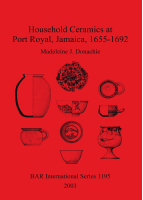Description
BOOK DESCRIPTIONFrom 1981 to 1990, the Institute of Nautical Archaeology (INA), in conjunction with Texas A&M University (TAMU) and the Jamaica National Heritage Trust, excavated a portion of the underwater English colonial city of Port Royal in Jamaica. Port Royal, animportant international commercial centre in the late 17th century, was destroyed in 1692 by an earthquake, which sank over half of the city beneath the waters of Kingston Bay. The INA/TAMU investigation has resulted in an extensive collection of artifacts and other material remains contemporary with the disaster. This study examines the ceramic inventory of one of the most fully excavated buildings in the heart of old Port Royal. As household wares, the pottery vessels recovered from the site provideimportant data on the customs and standard of living of the building's occupants. By extension, they reveal certain social aspects of the town as a whole and provide information about the kinds of material goods that were available to New World colonialsettlers at the end of the 17th century. Minimum vessel counts, by ceramic ware, form, and functional classification, are the basis for the analysis. The assemblage is looked at in the general context of all of the ceramics recovered from the Port Royal site, as investigated by INA/TAMU. It is also compared with similarly well-dated groups from two non-Jamaican sites. English pottery inventories from the 17th century and household probate inventories from Port Royal are examined to cast light on ceramic usage and markets. Social commentaries of the period and northern European paintings of interior scenes provide a snapshot of the everyday roles of ceramic vessels.











